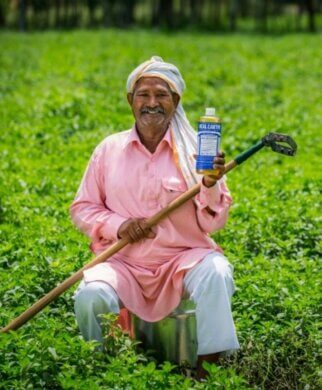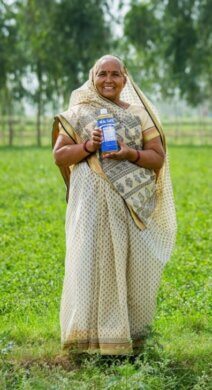“There wouldn’t be a Dr. Bronner’s today without our Peppermint soap, and there wouldn’t be Peppermint soap if it wasn’t for our partners in India making the organic Peppermint oil that goes into it.” Michael Bronner – President of Dr. Bronner’s
This year, we are celebrating 75 years of creating magic soap! The first ever scent, created by our founder Emanuel Bronner in 1948, is the cult favourite Peppermint. It has always been Dr. Bronner’s number one best-selling scent!
To reflect on this remarkable journey, we wanted to take you on an expedition to Pavitramenthe, located in India’s Uttar Pradesh state, where Dr. Bronner’s source the Regenerative Organic CertifiedÔ Peppermint essential oil used in our Peppermint-scented products.

Michael Bronner, President of Dr. Bronner’s, explains the magic behind the scent, “My grandfather always seemed to have the smell of peppermint radiating from his pores. He started making peppermint soap in small batches at home and he really wanted to make something that was more than a soap, but also a sensory experience… My grandfather put his philosophy on the bottle of soap and what this generation is doing is taking that message off the bottle and applying it wherever we can.”
What are the benefits of Peppermint?
Peppermint has been used for centuries for its cooling and soothing properties, with an important place in Indian Ayurvedic medicine and has many benefits for the skin. The unique aroma of Peppermint is also known to energise and revive, as well as helping to relieve congestion and headaches.
The Famous tingle! Peppermint is cooling and soothing, giving a refreshing effect on the skin. As well as the ‘tingle’ it can help soothe skin irritations, itching, and inflammation. The menthol in peppermint oil provides a cooling sensation that can offer relief to hot, irritated skin.
Antibacterial and Antimicrobial Properties: Peppermint oil has natural antibacterial and antimicrobial properties, which can help blemish and acne-prone skin. By reducing the presence of bacteria, peppermint oil can potentially prevent and control breakouts.
Oil Balancing: Peppermint oil has astringent properties that can help regulate oil production in the skin. It can be beneficial for people with oily or combination skin types as it may help reduce excessive oiliness and promote a more balanced complexion.
Skin Cleansing: The cleansing properties of peppermint oil make it a popular ingredient in skincare products. It can help remove dirt, excess oil, and impurities from the skin, leaving it feeling clean and refreshed.
Come with us to Pavitramenthe
 India is one of the leading producers of mint oil in the world, with a rich history in mint cultivation. It can be traced back to the Indus Valley Civilisation, which existed around 3000 BCE, and the production of mint oil dates back several centuries.
India is one of the leading producers of mint oil in the world, with a rich history in mint cultivation. It can be traced back to the Indus Valley Civilisation, which existed around 3000 BCE, and the production of mint oil dates back several centuries.
We began purchasing organic mint oil India’s Uttar Pradesh state, in 2003. After working with other suppliers, it began, in 2015, its relationship with Pavitramenthe in Bareilly, around 250 miles east of Delhi. Both share a vision of regenerative and fair farming in rural India and of using it for development. In its soaps, we use a blend of oils from two mint species, peppermint (mentha piperita) and corn mint (mentha arvensis); this blend perfectly balances the ‘menthol punch’ of the mentha arvensis and the more aromatic flavour of the mentha piperita. Both species are now grown by some 2000 smallholder farmers. Their small fields, typically less than two acres, are farmed in rotation, growing two or three different crops every year.
After the harvest, Pavitramenthe distils the leaves and purifies the mint oil at its processing facility. All farmers have been converting their farms to regenerative organic practices and the entire project has been regenerative organic certified since 2020.
What is Regenerative Organic Agriculture?
One of the key challenges for farmers in the region is the deterioration in the quality of the soil due to industrial agricultural practices. Unfortunately, after decades of intensive cultivation that previously included the use of chemical fertilisers and frequent ploughing, the soil had been depleted of nutrients (notably organic matter), which reduces the fertility of the soil.
In order to help farmers rebuild their soils and make it more productive and resilient, we initiated a comprehensive “soil regeneration” project in 2017. The practice of Regenerative Organic Agriculture mimics nature; farming in nature’s image by using no external chemical inputs, no synthetic fertilisers, no pesticides, creating a self-regenerating system. Pavitramenthe’s mint oil production is Fair for Life certified and Dr. Bronner’s is the largest personal care company certified under the USDA’s National Organic Program. The company is pursuing Regenerative Organic Certified (ROC) for as many ingredients in its supply chain as possible.
There are five core practices used to help reverse soil deterioration and bring back the carbon that’s been lost to the atmosphere:
- COMPOST: The production and application of compost, increasing the biomass content in the depleted soils, building soil fertility, increases its water holding capacity, fostering microbial life, and facilitating sequestration of atmospheric carbon.
- MULCHES: Using crop residues that are left on the fields to protect the soil and retain moisture.
- CONSERVATION TILLAGE: Regular heavy tilling, like ploughing, destroys soil structure, disturbs microbial populations and sends carbon into the atmosphere. Thus, a shift to conservation tillage practices, that do not go as deep and are not as destructive.
- COVER CROPS – These are grown to protect the soil in-between crops and to add biomass to the field.
- ROTATIONAL CROPS – Rotational nitrogen fixers – beans, lentils, peas – bring nitrogen back into the soil.
Social Projects: Breaking the Taboo – Menstrual Hygiene In India
As part of the partnership with Pavitramenthe, we have been working with the community on special projects, funded by the Fair Trade premium from the sale of mint oil. Projects are selected by a local committee, to ensure that they make real social change, such as: funding medical camps, the construction of home toilets, the distribution of water coolers for drinking waters, subsidising compost production and more.

A very important focus for our Dr. Bronner’s Special Operations Team is representing the women and children of the area, finding out their challenges and supporting their health and wellbeing. Menstrual health is still a taboo in India, with those menstruating often prevented from taking part in many aspects of daily life (such as being in the kitchen or attending temple). The lack of availability of proper sanitary care, due to both the cost and the shame associated with menstruating, makes women use materials with poor absorbency, such as straw, which can lead to infections. It also gets in the way of leaving the house or simply feeling comfortable. For example, it is estimated that 20% of girls stop going to school once their periods start.
So, how is Dr. Bronner’s helping? By investing in Relief Pads, reusable pads that are manufactured in India. These are distributed to women through schools and farming communities, and this is supported with an education programme to help lift the stigma and taboo around menstruation. These pads are revolutionary for many women; high quality fabric that is both absorbent and anti-microbial, they reduce the risk of infections and give women more personal freedom. They are washable and very economical. The initial programme has been hugely successful, and the work continues!
Inspired to try one of the Peppermint products? Shop the Peppermint range here: Shop all peppermint Dr. Bronner’s products here (drbronner.co.uk)
Dr. Bronner’s is a family business committed to honouring the vision of our founder Dr. E.H. Bronner by making socially and environmentally responsible products of the highest quality, and by dedicating our profits to helping make a better world. “All-One!”